Exploring the Role: What Does a Business Analyst Do and How?

Categories
What does a business analyst do? Here’s a one-stop shop for information about the business analyst job, skills, tools used, and career prospects.
In this article, I’ll discuss the role of a business analyst. I’ll talk about who business analysts are and what they do. Then, I’ll move on to the career outlook, meaning you’ll get insight into what skills you’ll need as a business analyst and how much you can earn in this role.
Who Is a Business Analyst?
Business analyst – commonly known as BA – is one of the job titles in the data science family. Business analysts analyze business operations and give recommendations on how to improve them. In other words, their role is optimizing processes, often including implementing new technology.
What Does a Business Analyst Do?
The shortest and most exact description of what business analysts do is that they act as a bridge between business needs and technical solutions.
Good, but how do they do that?
An Overview of What a Business Analyst Actually Does
From the high-level point of view, a business analyst’s job description consists of these five responsibilities.

1. Requirement Gathering: Working with stakeholders to understand and formalize their business needs. Simply put, business analysts need to understand how a certain process looks, what the people involved do, and how they do it.
2. Data Analysis: They analyze the collected data and look for patterns and areas for improvement.
3. Process Improvement: They identify improvements needed to the process, which may or may not require a software solution.
4. Solution Design: If a new software solution or improvements to the existing ones are needed, business analysts work with the development team on the solution design. It is to ensure that it meets business requirements.
5. Change Management: Business analysts make sure the transition from the old to the new process or solution is done smoothly.
Roles and Responsibilities of a Business Analyst
To get into even more specifics about the business analyst’s job, we first need to know what the business analysis process looks like.
We can visualize it this way.
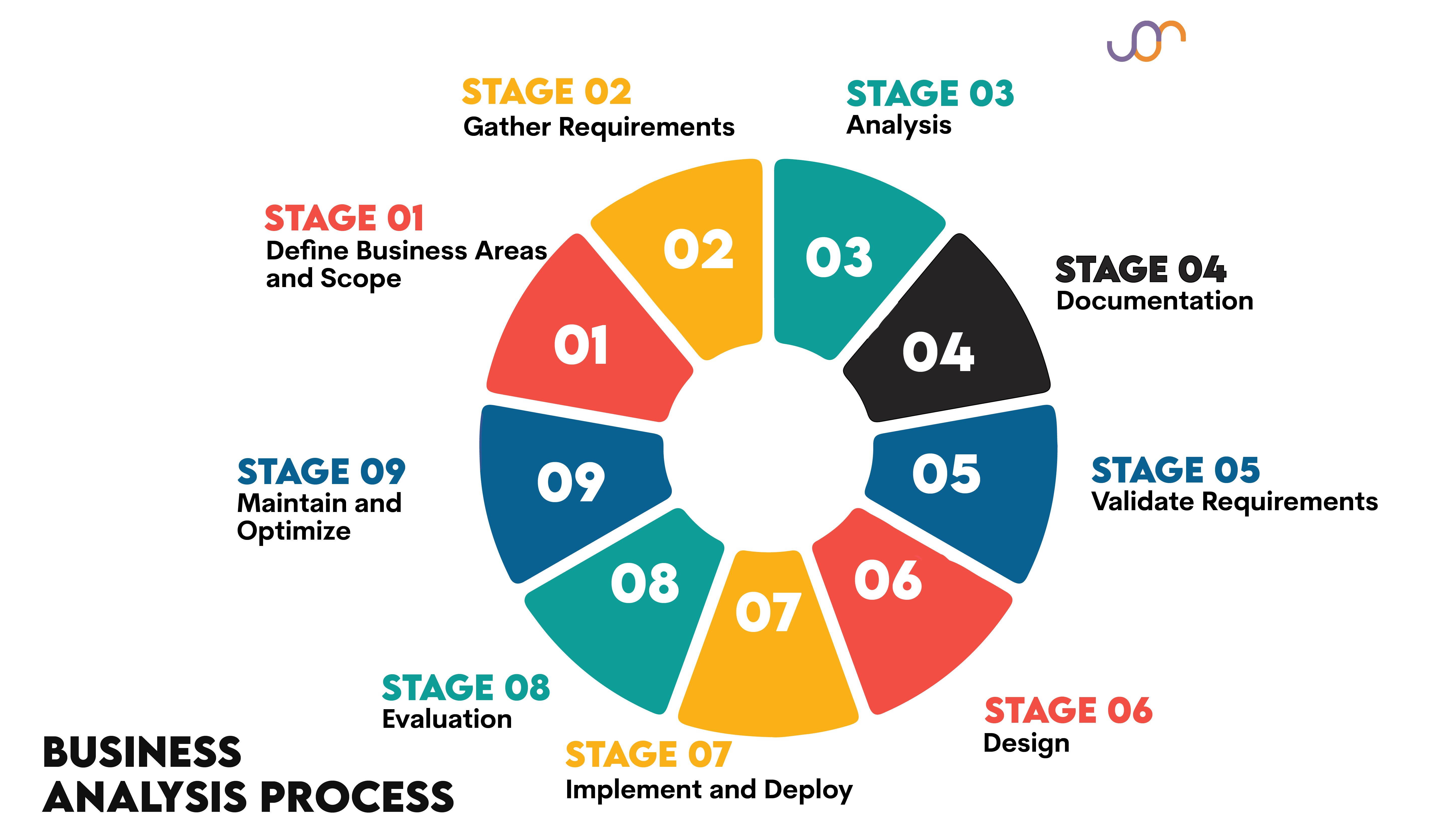
The business analyst’s responsibilities are directly related to the stages of the process. By knowing the importance of each stage and techniques used, the exact role and responsibilities of a business analyst will start to unravel in front of your eyes.
1. Define Business Areas and Scope
In this initial stage, BAs identify the areas of business that will be affected by the project. Its purpose is to establish the scope and the focus of the project so that it’s managed effectively and all the relevant sides of the business are involved.

There are several reasons why this stage is important.
1. Focusing the Efforts: With clearly defined objectives and the scope of the project, it’s easier to concentrate on relevant business areas and avoid misallocation of resources.
2. Identifying Stakeholders: Connected with the point above, this stage is also used to identify stakeholders. That way, everybody impacted by the project can be involved.
3. Risk Management: The project's potential risks can be identified in this stage, enabling their management.
4. Setting Clear Objectives: The precise objectives of the project have to be set against which the success or failure of the project will be measured.
5. Resources Optimization: With the clear objectives and scope of the project, it’s easier to utilize resources efficiently, i.e., time, staff, cost, etc.
6. Scope Creep Management: This stage prevents scope creep, i.e., the uncontrollable increase in the project’s scope.
Business analysts can use these techniques to achieve these objectives.

1. SWOT Analysis: The SWOT analysis is used to identify strengths, weaknesses, opportunities, and threats of the project.
2. Use Case Diagrams: A use case diagram shows how the systems and external entities interact. Visualizing it gives you a clearer picture of the project scope.
3. Scope Modeling: This technique involves creating visual models (e.g., context diagrams) that represent the project scope, including systems, processes, and stakeholders.
4. Business Process Mapping: To easily understand business processes and identify needed improvements, BAs can create visualizations of existing processes.
5. Stakeholder Analysis and Mapping: BAs have to identify and thoroughly understand stakeholders, their roles, and their impact on the project. That way, it’ll be easier to meet their business needs.
6. Feasibility Study: Its purpose is to establish the project's viability, ensuring that the assumptions and expectations are realistic, considering available resources.
7. Work Breakdown Structure (WBS): WBS is used as a tool to break down the project into smaller parts that the project team will work on.
8. Requirements Workshops: These workshops gather stakeholders and collaboratively understand different stakeholder groups' specific, sometimes even contradictory, requirements.
2. Requirement Gathering
In the next stage of business analysis, also called requirement elicitation, BAs work with stakeholders to understand and document their business requirements and current business processes. This aims to ensure the project team that will design and implement solutions understands the business requirements.
There are several reasons this stage is important.

1. Clear Guidelines: The gathered requirements will serve as guidelines for the project team, making sure the implemented solution meets the stakeholders’ business needs.
2. Risk Management: When the requirements are clearly defined and well documented, it’s easier to identify potential risks, thus making it possible to manage them in this early stage.
3. Optimizing Resources: Well-understood requirements make it possible to allocate needed resources. In other words, forming a project team of an adequate size and expertise, along with outlining realistic timelines for the milestones. Also, there will be fewer surprises along the way and, ideally, no need to constantly go back to this stage and revisit the business needs.
There are many techniques available to BAs for this stage. They depend on the type of project and the size of the company. Usually, several of these techniques are used simultaneously.
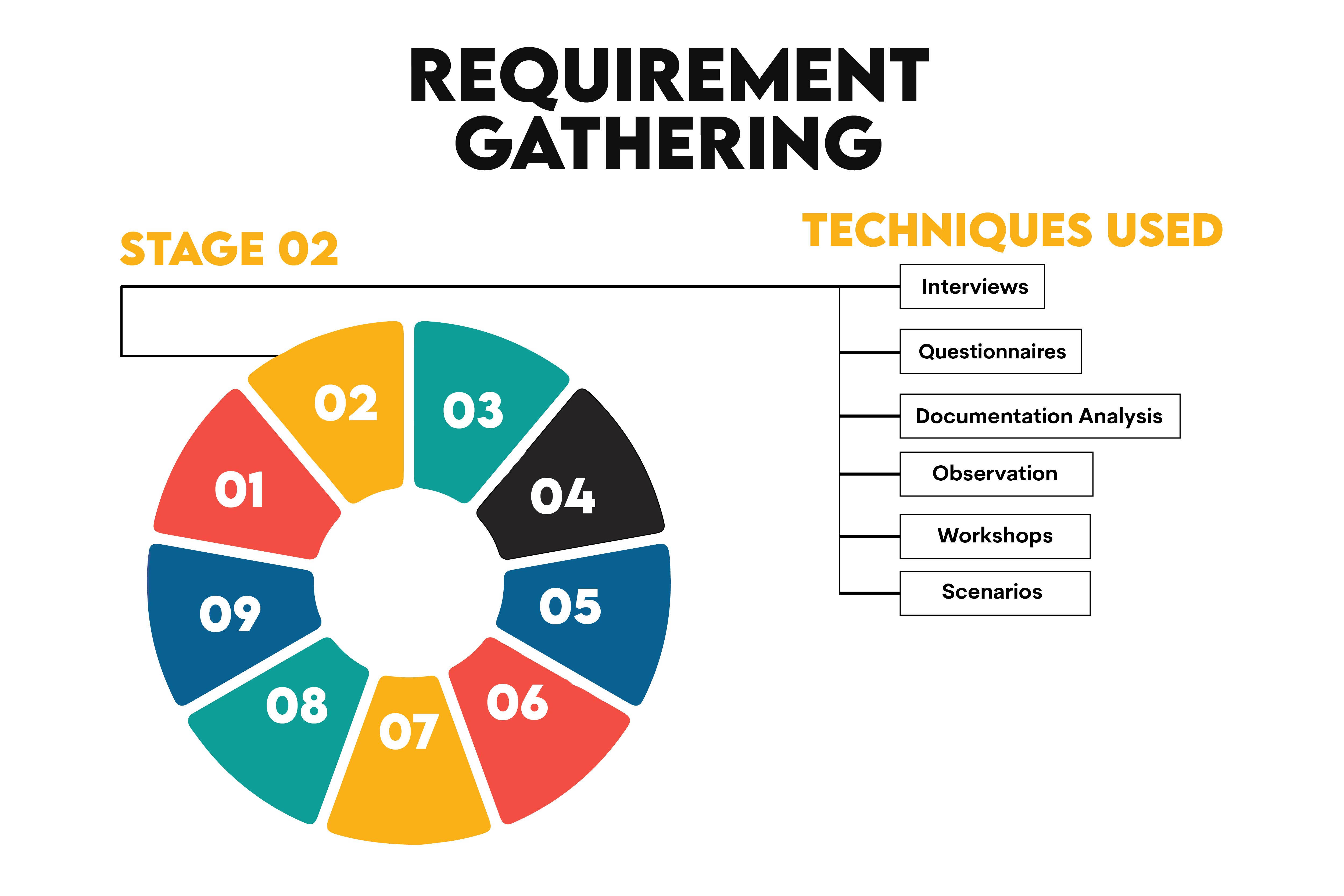
1. Interviews: The requirements can be gathered in one-on-one or group interviews.
2. Questionnaires: Interviews are sometimes very time-consuming. Questionnaires can be used instead of or to complement them. Having stakeholders fill in the questionnaires gives the collected information a structured form.
3. Documentation Analysis: Business analysts also need to analyze the existing documentation, such as company policies, procedures, manuals, and system documentation. The purpose is to understand the current processes, which will serve as a basis for their improvement.
4. Observation: BAs can also directly observe how the stakeholders work to understand workflows better.
5. Workshops: One of the tools BAs have at their disposal is workshops. In other words, organizing meetings where stakeholders can define requirements through collaboration.
3. Analysis
The third crucial role of business analysts is the analysis of the gathered requirements. It aims to structure collected information, understand, refine, and prioritize the requirements. In this stage, business analysts extract insights from data that will be used in informing the stages of the project.
Here’s why this stage is important.
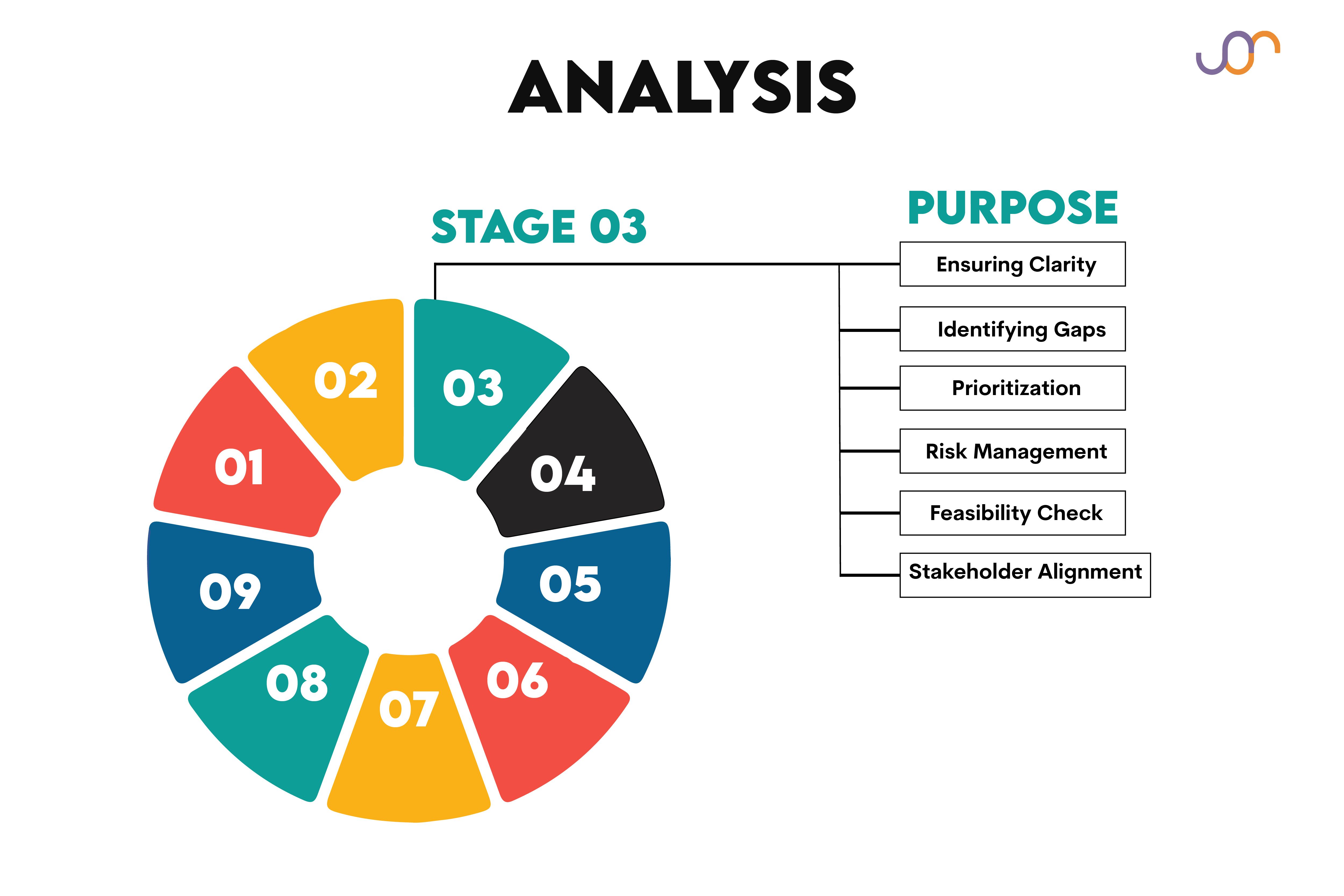
1. Ensuring Clarity: It ensures the requirements are clearly defined and unambiguous.
2. Identifying Gaps: This stage is used to recognize if there are any missing requirements or pieces of information that could significantly impact the project.
3. Prioritization: Business analysts have to determine each requirement's priority, ensuring that the most critical requirements are first met.
4. Risk Management: This stage also helps identify and manage risks connected to the requirements.
5. Feasibility Check: During analysis, BA checks the feasibility of the requirements. In other words, whether they are realistic and achievable.
6. Stakeholder Alignment: This phase ensures that stakeholders understand and agree to all the requirements and proposed solutions.
The techniques used in this stage are shown below.

1. SWOT Analysis: Business analysts once again use SWOT analysis to understand the factors that could impact the project.
2. MOST Analysis: They also use the MOST analysis (Mission, Objective, Strategies, Tactics) to make sure that the project is in line with the company’s business strategy.
3. Use Case Analysis: With the help of the stakeholders, BAs develop use cases that explore whether the solution will be able to meet all the business requirements.
4. User Stories and Epics: Business analysts create user stories and epics to define the users’ needs concisely.
5. Functional Requirement Analysis: This type of analysis means analyzing the requirements regarding the proposed solution functionality, i.e., what it should do.
6. Non-Functional Requirement Analysis: This technique means analyzing the requirements in relation to what the solution should be, i.e., its accessibility, data integrity, robustness, stability, etc.
7. Gap Analysis: Business analysts have to identify the gaps between the capabilities of current and future systems using gap analysis.
8. Impact Analysis: The project's changes have to be analyzed, and their impact on the company has to be assessed. This is impact analysis.
9. Cost-Benefit Analysis: BAs have to confront the expected benefits of the project and the cost to achieve them in a cost-benefit analysis.
10. Data Flow Diagrams: The data flow has to be visualized to understand how the data moves through the company. In other words, it has to be clear where and how data is stored, processed, and used. Data flow diagrams are used for that.
11. Requirement Prioritization Matrix: Business analysts use a matrix to visualize the requirements’ importance compared with the cost of implementing them.
4. Documentation
Once all the above is done, business analysts must document requirements in detail. The documentation needs to be accurate and comprehensive but also understandable, as it will be presented to all the stakeholders and project team members.
This stage is vital for the following reasons.

1. Clear Communication: All the requirements have to be communicated comprehensively and clearly to the stakeholders for validation and then further on to the development team.
2. Traceability: The documentation helps track and stick to the requirements as the project progresses.
3. Risk Management: If the documentation is detailed and clear, misunderstandings and miscommunication are minimized.
4. Quality Assurance: Documentation serves as a basis for defining the criteria the implemented solution must meet.
5. Change Management: Documentation provides a basis against which the implemented changes can be evaluated.
6. Compliance: It ensures compliance with the legal and regulatory requirements.
In this stage, business analysts use the following techniques.
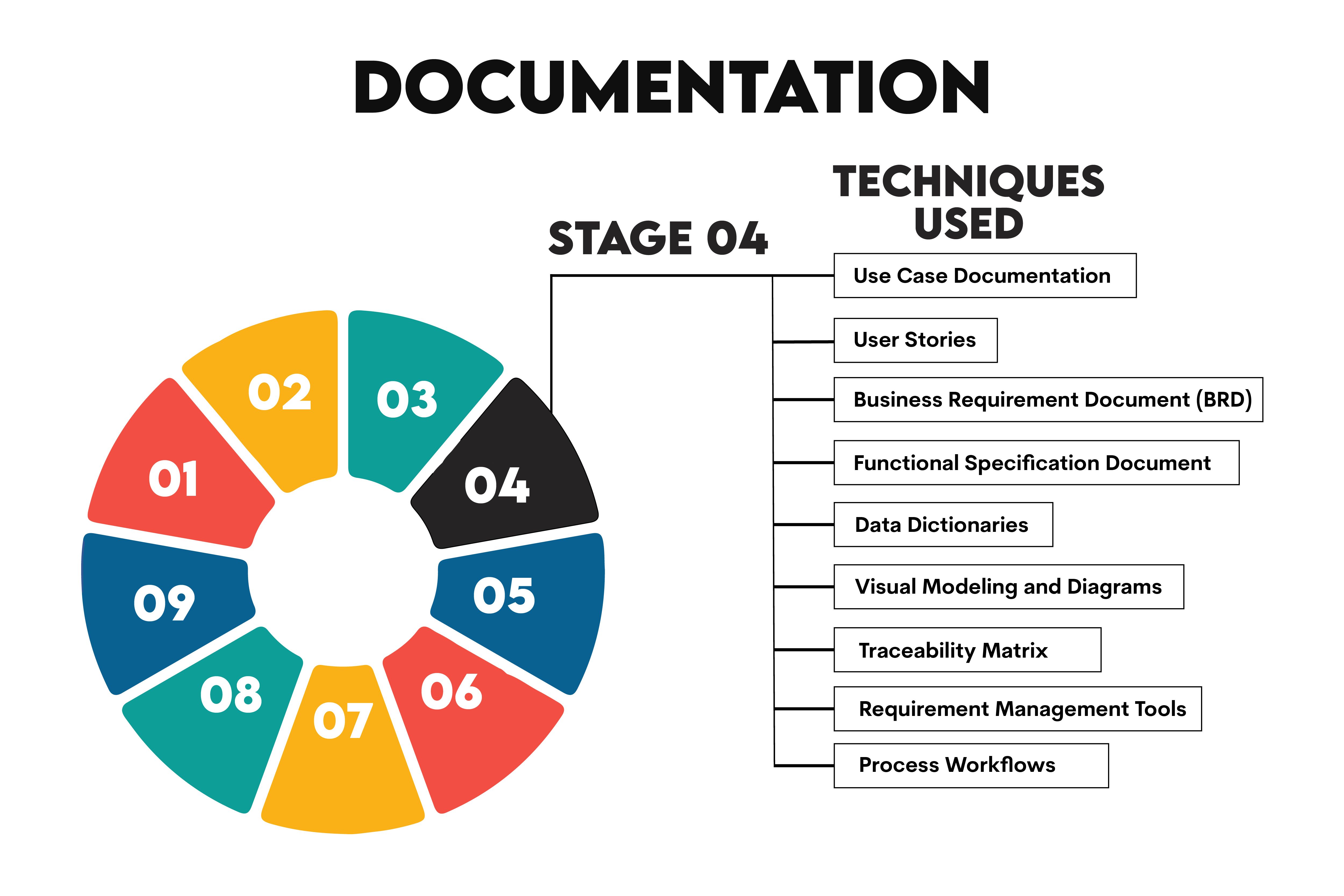
1. Use Case Documentation: Using the scenarios, BAs describe how the end-users interact with the system to understand the system’s functional requirements.
2. User Stories: With the help of user stories, BAs once again create concise descriptions of the system’s features from the perspective of various end-users.
3. Business Requirement Document (BRD): The BRD is a document with detailed information on the business problems, proposed solutions, involved stakeholders, functional and non-functional requirements, etc.
4. Functional Specification Document: The FSD gives detailed descriptions of the system’s features in terms of data handling, user interface, etc. In other words, it describes what the system is supposed to do.
5. Data Dictionaries: Business analysts create data dictionaries, which are repositories of data where each data element is defined. It involves the meaning, origin, usage, format, and relationship with other data elements.
6. Visual Modeling and Diagrams: The diagrams such as data flow, entity-relationship (ER), and state-transition diagrams are used to visualize data flows, structure, and the behavior of the system.
7. Traceability Matrix: Business analysts use a traceability matrix to connect the users’ requirements with the test cases.
8. Requirement Management Tools: Business analysts have at their disposal tools such as Jira, Confluence, or Microsoft Azure DevOps. They are used to document, manage, and track requirements.
9. Process Workflows: They are used to visually represent all the steps required for a particular task from start to finish.
5. Validating Requirements
This is the next stage in business analysis. It serves as validation that the requirements gathered and documented in the previous stages are in line with the expectations of the stakeholders.
Validating requirements is important for the following reasons.

1. Ensuring Accuracy: It checks the accuracy of everything documented so far.
2. Risk Management: As with any stage so far, this one also helps in identifying and managing potential risks early enough in the project.
3. Avoiding Rework: It minimizes the possibility of going back to the initial stages of the project and re-checking the business needs once the implementation starts.
4. Stakeholder Alignment: This phase ensures that all the stakeholders have a clear understanding and agreement on the requirements.
5. Resources Optimization: It helps with the utilization of resources in an efficient manner.
6. Quality Assurance: Builds a foundation for the high quality of the final solution, as it will be built on corroborated and agreed-upon requirements.
Here are the techniques BAs use in this stage.

1. Requirements Review: Together with the stakeholders, BAs review the documented requirements.
2. Use Case Testing: BA and stakeholders create test cases that will be used to check if the solution can perform all the business requirements.
3. Traceability Matrix: Business analysts use a traceability matrix to connect the users’ requirements with the test cases.
4. Model Validation: This involves using data models, process models, or UI models to validate that the requirements are correctly represented and are achievable.
5. Acceptance Criteria Definition: BAs make sure the criteria that the solution must meet are clearly defined and agreed upon.
6. Peer Review: BAs can also engage peers when reviewing requirements.
7. Stakeholder Feedback: The sessions are organized where BA gathers stakeholder feedback.
8. Requirements Workshop: There can also be workshops where stakeholders collaborate, review and validate requirements.
6. Design
In this stage, we’re finally getting close to implementing the actual solution. Before the implementation itself, business analysts have to provide the blueprint for the solution. Again, it has to align with all the findings and documentation from the previous stages.
Here’s what makes this stage important.

1. Development Blueprint: It provides a guide to developers and testers for building and testing the solution.
2. Stakeholder Visualization: The stakeholders can see what the final solution will look like and if it’s in line with their expectations.
3. Risk Management: The blueprint makes it easier to identify the issues with the solution design before the actual development begins.
4. Cost Estimation: As the solution is now beginning to take a tangible form, it’s easier to understand the solution’s components and its complexity. In return, it makes it easier to estimate costs more accurately.
5. Quality Assurance: With comprehensive design descriptions and visualization, it’s easier to meet quality standards.
6. User Experience Optimization: It allows the creation of a design that is user-friendly and improves its usability.
To achieve these goals, BAs use these techniques.

1. Wireframes: The wireframes are illustrations that represent the basic design elements of the future solution. They mainly focus on the content that will be shown and how it will look on the screen.
2. Prototyping: The working model is created to show end-users its design and functionalities.
3. Use Case Diagrams: The use case diagram’s purpose is to visualize how the end-users will interact with the system.
4. Data Modeling: Business analysts can also use a data model to present how data is stored, managed, and accessed.
5. Interface Design: The interface should improve the solution’s usability so the business analysts dedicate their time to it.
6. Architecture Design: Business analysts are also involved in architecture design, defining the solution’s components, their relationships, and how they interact with the end-users.
7. Workflow Diagrams: Utilizing visual representations to define processes and workflows, ensuring that they align with process requirements and optimize performance.
8. Mockups: The mockups are visual representations of the solution’s look and feel, enabling stakeholders a realistic view of the final solution.
9. Storyboarding: Business analysts can also use illustrations that showcase the end user’s navigation through the solution once it’s implemented.
10. Design Thinking Workshops: BAs can also more actively engage stakeholders by organizing workshops where they will participate in developing design concepts.
7. Implementation and Deployment
Finally, all this work can now materialize into a functional solution. This is the phase where the solution is developed, tested, and deployed to production.
Why is this stage important? Well, the whole point of business analysis is condensation in this stage: implementing the solution that meets the users’ needs and improves particular business processes within the organization.
Apart from the obvious, this stage is important for several other reasons.

1. Delivering Value: This stage ensures that the implemented solution delivers what was expected and gives value to the stakeholders and the business as a whole.
2. Risk Management: It also makes it possible to identify and mitigate issues with the solution before it’s deployed to production.
3. Quality Assurance: Business analysts use this stage to ensure the implemented solution meets defined quality standards.
4. Change Management: This stage also manages the transition from the old system or process to a new one with minimal disruption to the business.
Business analysts use the following techniques in this stage.

1. Change Management Techniques: Using strategies to manage organizational change to transition to a new system, including communication between the business stakeholders and technical teams.
2. User Acceptance Testing (UAT): UAT tests are done by end-users with the purpose of testing if the solution satisfies their needs before the deployment.
3. Training and Development: Business analysts organize training sessions for the end-users to make sure they know how to use the solution.
4. Deployment Planning: BAs also need to plan how the solution will be deployed.
5. Communication: Business analysts have to keep all the stakeholders in the loop about the progress of the implementation phase.
6. Tracking Issues: This means identifying, tracking, and managing all the issues that arise during the implementation.
7. Rollback Planning: If the implementation fails or some issues are discovered after the deployment, there needs to be a plan for rolling back all the changes to the system or process.
8. Evaluation
In the evaluation phase, business analysts assess the outcomes of the implemented solution against the initial objectives. This ensures that the solution gives tangible results to the stakeholders and business.
The importance of this stage is mirrored in the following.

1. Measuring Success: It assesses whether the project achieved its objectives and to what degree.
2. Identifying Gaps: It identifies any discrepancies between the expectations and reality.
3. Improvement: In this stage, business analysts can identify if there are some improvements that the implemented solution requires.
4. Learning: Each project is also a ground for learning. It happens in this stage, where business analysts can get insights that can be useful in further projects.
To achieve all this, business analysts use the following techniques.

1. Key Performance Indicators (KPI) Monitoring: Analyzing KPIs to determine the performance, impact, and success of the solution.
2. Surveys and Feedback: They gather feedback from the end-users and stakeholders to assess their satisfaction with the solution and identify the areas of improvement.
3. Benefit Realization Analysis: They evaluate the actual benefits against the expected benefits and potentially even discover some not foreseen ones.
4. Gap Analysis: They identify and analyze the discrepancies between the expected and actual outcomes and plan how to address them.
5. Return On Investment (ROI) Analysis: It’s a common profitability metric also used in business analysis to compare the financial value of the solution and its costs.
6. Usability Testing: Business analysts conduct tests to evaluate the end-users' satisfaction with the solution.
7. Post-Implementation Review: They analyze the project’s process and outcomes to learn what can be applied or improved in future projects.
8. Performance Metrics Analysis: They come up with and analyze performance metrics for assessing the solution performance.
9. Lessons Learned Workshops: Business analysts can organize workshops where they can get feedback on the project from the project team members and stakeholders.
10. Cost-Benefit Analysis: They go back to the cost-benefit analysis and re-evaluate it.
9. Maintenance and Optimization
This is the final stage of the business analysis process. But it’s also an iterative stage in which the business analyst makes sure that the implemented solution/change continues to deliver value to the stakeholders and business as the needs evolve and until a completely new solution is again needed.
Here are the reasons why this stage is part of the business analysis process.

1. Continuous Value Delivery: It makes sure that the solution delivers value as long as possible.
2. Adaptability: It ensures change to the solution in line with the changing business environment, needs, and technologies.
3. Makes Improvements: Most solutions will require some tweaking and improvements once they are deployed.
4. Quality assurance: This phase ensures that the solution continues adhering to the set and changing quality standards.
5. Stakeholder Satisfaction: To make sure the stakeholders are still satisfied with the solution.
These are the techniques applied in this phase.

1. Performance Monitoring: Continuous analysis of the solution’s performance.
2. User Feedback Systems: Business analysts can implement systems that will gather, analyze, and act upon end-user feedback.
3. Root Cause Analysis (RCA): The RCA identifies and addresses the root causes of the problems with the solution.
4. Change Management: If the changes to the solution need to be made, this has to be managed and communicated.
5. Regression Testing: Regression testing involves re-running functional and non-functional tests to check if the updates and changes to the solution negatively impact the existing solution.
6. Service Level Agreement (SLA) Monitoring: The SLAs are used for detailing between the client and the service provider. By monitoring the agreements, business analysts ensure the agreed-upon services on the solution are performed.
7. Updating Documentation: Business analysts need to update documentation and knowledge bases so that they reflect the current state of the solution.
8. Capacity Planning: Planning the future capacity needs that must be reflected in the solution updates.
9. Cost Management: Cost optimization of the solution maintenance.
10. Technology Assessment: Business analysts need to be in the loop of technological developments for further solution improvements.
Tools One Should Know as a Business Analyst
The tools business analysts use are directly related to their job description. Here’s an extensive list of the tool categories and some of the most commonly used tools.

Business Analyst Career Outlook
As with all the data science jobs, business analysts are still one of the more attractive jobs. According to Glassdoor, business analysts are 36th of the 50 best jobs in the US in 2022.

While it might not seem that high compared to data scientists (top 3), being among the top 50 jobs is highly commendable.
If we take the number of job openings in 2022 in the US from the source, we can see that business analysts are among the ten jobs with the highest demand. More specifically, it’s ranked as the ninth. Not bad!
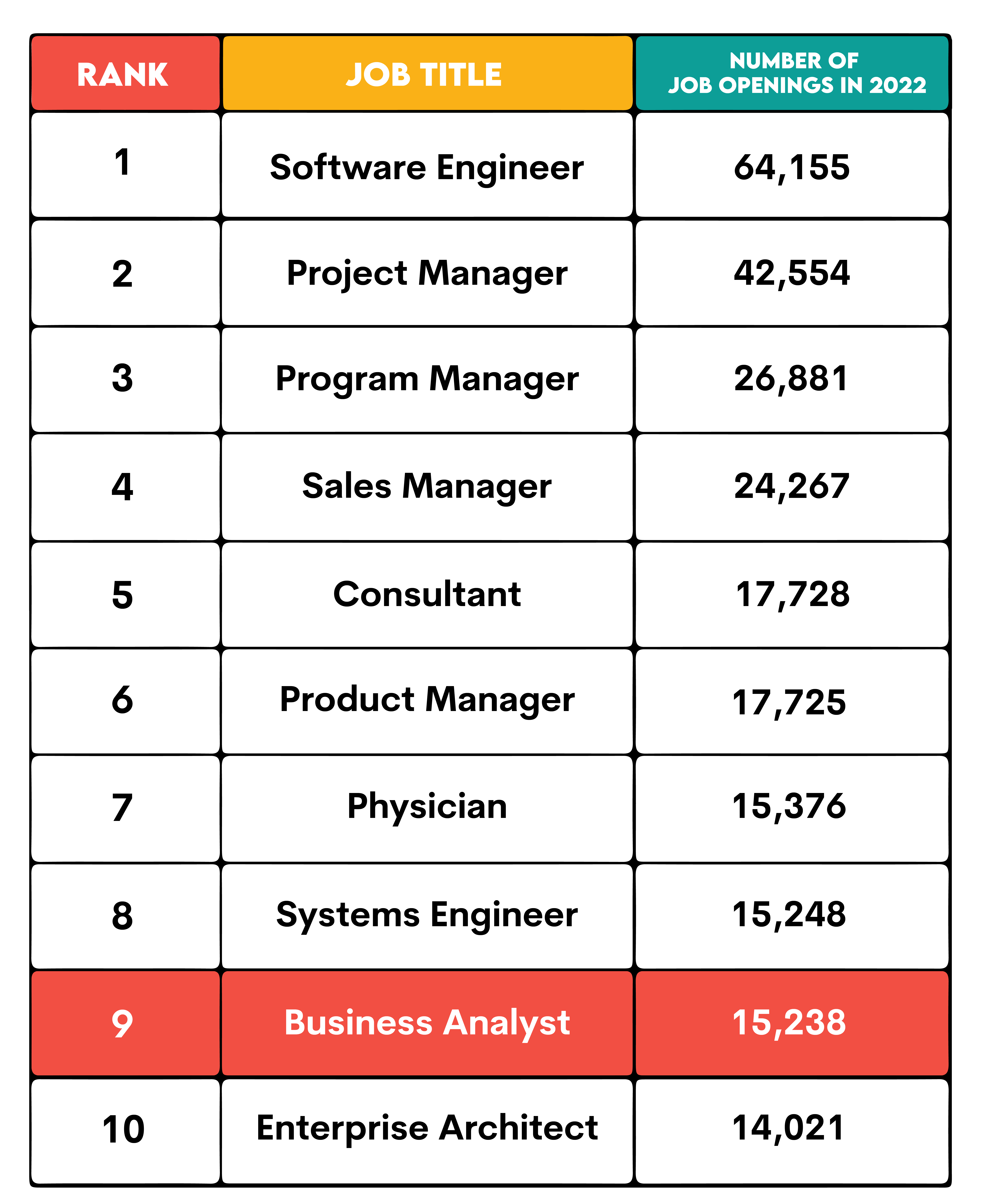
But what about the future? Will a business analyst job be as attractive?
According to the U.S. Bureau of Labor Statistics, the management analysis (this includes business analysts) job will grow 10% between 2022 and 2032. They also project there will be, on average, 92,900 new openings for this job each year of the decade. This is categorized as ‘much faster than average’.
So, yeah, if you find this job interesting, it would be a good decision to start investing in the necessary knowledge.
Skills Required to Become a Business Analyst
To become a business analyst, you’ll have to showcase a very specific range of skills. Business analysts are living in the Middle-earth between the business and technical worlds. This is reflected in the typical characteristics they show, which are not limited to short stature, having hairy feet, and not wearing shoes.

Analytical Skills: BAs have to be able to understand, analyze, and interpret complex data and processes. They need to structure the collected data and gain insights from it. They also use their analytical skills to find ways to improve the processes and develop solutions that will align with the requirements.
Communication Skills: Business analysts have to be skillful communicators in oral and written form. First, they must be good listeners, as they must understand all the stakeholders' requirements. The communication skills also translate into creating comprehensive but easily understood documentation. This documentation serves to validate all the needs and then pass it on to the development team. If the business analysts weren’t good communicators, crucial information could be distorted between the business analysis project's beginning and end.
Problem-Solving Skills: They need to identify problems in any project segment and be able to resolve them quickly and efficiently. These problems can range from communication issues between the teams, changes in requirements or the available resources to limits in the available technology, issues with the implemented solution, etc.
Technical Skills: While the business analysts are not developers themselves, they do understand the technology well enough to provide the development team with quality requirements and monitor their fulfillment. They also need to be in the loop with the latest technologies available on the market and solutions used in other companies. Not only that, but they also need to be skilled in using a wide range of tools.
Business Skills: Business analysts need to understand the business side of how the company works. This includes knowing the organization, company’s products, processes, and industry. After all, they need to understand what the stakeholders want, assess the feasibility of the requirements, and prioritize between them.
Project Management Skills: The business analysis process is nothing but project management with some specific skills. So, you need to be able to manage projects from start to finish. This means coordinating teams, milestones, costs, and milestones. In short, be in the project’s driver’s seat and ensure everything goes as smoothly as possible.
Business Analyst Salary
The business analyst’s salary usually consists of the base and additional compensation.

Using Glassdoor as a source, the base business analyst's annual salary in the US is in the $65K - $99K range. The additional salary is somewhere between $5K and $9K.
So you can expect your total salary from $70K to $108K, with a median salary of around $86K.
Let’s see how this compares to other data science jobs.

Of the 14 data science jobs, business analyst is among the bottom three regarding the pay in the US. While you could now ask, ‘Why bother?’, let’s put it in a broader context. According to the US Bureau of Statistics, the median weekly pay in the US is $1,100. On a yearly basis, that is $57,200.
Compared to the business analyst median of $86K, business analysts will earn, on average, $29K or 50% above the national median.
It now sounds much better, right? Considering the high demand for this job, it provides many opportunities to earn good money. And, preferably, do that while enjoying what you do.
Conclusion
After reading this article, hopefully, it’s much clearer what business analysts do and how. The set of skills you need for this job is quite interesting. While this is a technical job, it’s one of the data science jobs where business skills, communication, and project management are at least equally important.
StrataScratch is a good source for information and learning all these skills. In most cases, SQL is the language business analysts use for querying databases and analyzing data. You can practice it in StrataScratch’s coding questions section. As for the business case, product, system design, and technical questions, they are in the non-coding questions section.
To get a feeling of how the business analyst job interview might look like, read this article with business analyst interview questions. You can find many other valuable articles in our blog, e.g., the one with the Amazon business analyst questions.



